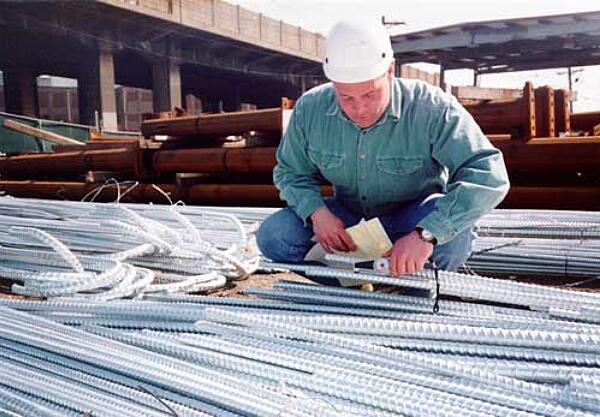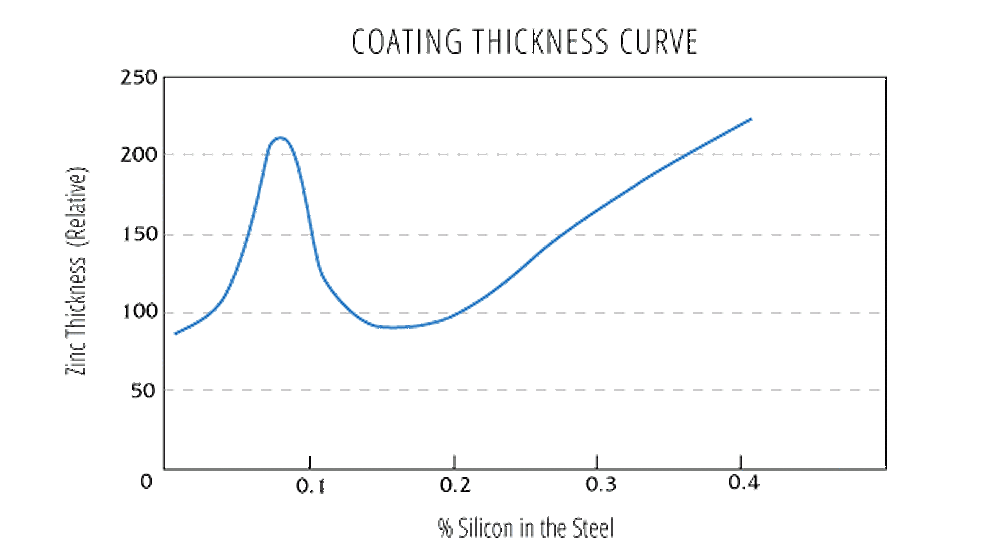Design and Specification
Once the decision has been made to specify hot-dip galvanized steel, it is important to open the lines of communication between the specifier, fabricator, and galvanizer. Communication early in the design process is key to producing optimum quality galvanized coatings, minimizing cost, and improving turnaround times. Corrosion protection begins at the drawing board, and incorporating appropriate design details and principles will ensure success. For more detailed information on Design & Fabrication, register for the Design Seminar.
Designing Rebar for HDG
When galvanized steel is specified (see the AGA's publication, Suggested Specification for Hot-Dip Galvanizing Reinforcing Steel) the design requirements and installation procedures employed should be no less stringent than for structures where uncoated steel reinforcement is used. In addition, there are some special requirements to be observed when galvanized steel is used. The following suggestions are intended as a guide for designers, engineers, contractors, and inspectors. They are intended as a supplement to other codes and standards dealing with the design and fabrication of reinforced concrete structures and deal only with those special considerations that arise due to the use of galvanized steel.
The most important rule of designing for galvanizing is communication between the designer, fabricator, and galvanizer throughout the process. Communication with the galvanizer before the part is fabricated can help optimize turnaround times, minimize costs, and ensure a high-quality galvanized coating. This triad of communication can prevent the disappointment of unmet expectations.
Specifying HDG Reinforcing Steel
There are three main specifications that govern the coating thickness, adherence, and finish for hot-dip galvanized coatings ASTM A123, A153, and A767. A123 is the main specification and covers all types of galvanized products except fasteners and small parts which are covered by A153, and reinforcing steel bars, covered by A767. There is a handful of supporting specifications referenced in these specifications that cover design practices, repair and touch-up, and painting over galvanizing. In conjunction with ASTM, the AGA publishes a compilation of these specifications, Selected Specifications for Hot-Dip Galvanizing, which can be purchased from the AGA
ASTM A123: Specification for Zinc (Hot-Dip Galvanized) Coatings on Iron and Steel Products covers the requirements for galvanizing by the hot-dip process on iron and steel products made from rolled, pressed, and forged shapes, castings, plates, bars, and strips. Covers both un-fabricated products and fabricated products, for example, assembled steel products, structural steel fabrications, large tubes already bent or welded before galvanizing, and wire work fabricated from uncoated steel wire. This specification also covers steel forgings and iron castings incorporated into pieces fabricated before galvanizing or which are too large to be centrifuged (or otherwise handled to remove excess galvanizing bath metal).
ASTM A123 does not apply to wire, pipe, tube, or steel sheet which is galvanized on specialized or continuous lines. The specification includes minimum coating thicknesses according to material category as well as finish and adherence requirements.
ASTM A767: Specification for Zinc-Coated (Galvanized) Steel Bars for Concrete Reinforcement covers zinc coatings applied by the hot-dip process on individual steel reinforcing bars before fabrication used in concrete. The specification says bars shall have NO bare spots and shall be free from tears or sharp spikes which make the bar hazardous to handle, and bars that stick together after galvanizing shall be rejected.
Minimum bend diameters for finished bars are included in the specification to prevent the coating from flaking on bend radii, as are requirements for coating thickness according to bar size. All rebar fabrications shall be galvanized to the requirements of ASTM A123.
Mechanical Properties
Studies of hot-dip galvanizing on the mechanical properties of reinforcing steel show little effect on the tensile or yield strength or the ultimate elongation of rebar, provided appropriate steel selection, fabrication practices, and galvanizing procedures are followed. When rebar is fabricated prior to hot-dip galvanizing, bend radius should follow Table 2 of ASTM A 767, Standard Specification for Zinc-Coated (Galvanized) Steel Bars for Concrete Reinforcement. If rebar is fabricated after galvanizing, standard industry practice, as per the Concrete Reinforcing Steel Institute's (CRSI) Manual of Standard Practice, should be followed.
Additionally, the effect of galvanizing on the ductility of steel bar anchors and inserts after being subjected to different fabrication procedures has been investigated. The study concluded with the correct choice of steel and galvanizing procedures, galvanizing causes no reduction in the steel's ductility. An extensive experimental program examining the fatigue resistance of steel reinforcement shows deformed reinforcing steel, exposed to an aggressive environment prior to testing under cyclic tension loading, performs better when galvanized.
Steel Selection and Dissimilar Metals
Reinforcing steel to be galvanized shall conform to one of the following ASTM specifications: A615: Specification for Deformed and Plain Billet-Steel Bars for Concrete Reinforcement, or A706: Specification for Low-Alloy Steel Deformed and Plain Bars for Concrete Reinforcement.
Another design consideration when utilizing galvanized reinforcement is the possibility of establishing a bimetallic couple between zinc and bare steel (i.e. at a break in the zinc coating or direct contact between galvanized steel and black steel bars) or other dissimilar metals. This type of bimetallic couple in concrete should not exhibit corrosive reactions as long as the two metals remain passivated. To ensure no reactions occur, the concrete depth to the zinc/steel contact should not be less than the cover required to protect black steel alone under the same conditions.
Best practice dictates when using galvanized reinforcement, it should not be directly connected to large areas of black steel reinforcement, copper, or other dissimilar metals. Bar supports and accessories should be galvanized, and tie wire should be annealed wire 16-gauge or heavier preferably galvanized. If dissimilar metals must be used, polyethylene and other non-conducting tapes can be used to provide insulation between the metals.
Coating Thickness

The thickness of the galvanized coating is the primary factor in determining the service life of the product. The thicker the coating, the longer it provides corrosion protection. For steel embedded in concrete, the relationship is approximately linear.
The galvanized coating thickness can be determined via several methods. The size, shape, and number of parts to be tested likely dictates the method of testing. The most common method for measuring coating thickness on reinforcing steel bar and assemblies is by magnetic thickness gauge in accordance with ASTM E376, Standard Practice for Measuring Coating Thickness by MagneticField or Eddy-Current (Electromagnetic) Examination Methods.
Factors Affecting Coating Thickness
There are several factors that affect the zinc coating thickness, some which are manageable by the galvanizer and others that are not. The two readily manageable by the galvanizer are the temperature of the zinc bath and the withdrawal rate of the reinforcing bar from the zinc bath. To a lesser degree, the roughness of the surface affects the coating thickness. Therefore, parts that have been over-pickled and are rough on the surface can develop thicker zinc-iron layers. One condition, uncontrollable by the galvanizer, which significantly affects the outcome of the finished galvanized coating, is the steel chemistry namely silicon and phosphorous content. Certain levels of silicon and phosphorus tend to accelerate the growth of the zinc-iron alloy layers so the coating continues to grow the entire time the reinforcing steel is immersed in the zinc bath.

The Sandelin Curve shows the coating thickness produced by steels with different silicon levels immersed in the zinc bath for equal amounts of time. Following the Sandelin curve, there are two ranges of silicon content recommended for steels to be galvanized, below 0.04% OR between 0.15% and 0.22%, as detailed in ASTM A385, Practice for Providing High-Quality Zinc Coatings (Hot-Dip). Generally, steels with silicon content outside these ranges produce thick coatings characterized by a matte gray surface, indicating a predominately zinc-iron intermetallic coating with little or no free zinc outer layer.
Though service life is linear to the amount of zinc coating, hot-dip galvanized coatings more than 12 mils (305 microns) thick can be susceptible to damage from rough handling. These thick coatings may experience flaking of the outer free zinc layer in areas where external stress is put on the bars. In more extreme cases, the coating can fracture at the interface between separate zinc-iron intermetallic layers, leaving only a fraction of the original coating thickness.
One other factor affecting coating thickness is the blend of various bar sizes in a reinforcing steel assembly. Different size bars will develop zinc coating at different rates. The assembly must be kept in the zinc bath for a longer time in order to develop the minimum required thickness on thicker sections; therefore, smaller bars in the assembly tend to have thicker than normal coatings, which will be more pronounced if the silicon levels are outside the recommended ranges.
Bending
Different types of steel have different properties, including chemistry, strength, aging characteristics, etc., and these properties will influence the cold working properties of the steel. Because most black steel reinforcing bar is made primarily of scrap iron and has many different steel chemistries, different bend recommendations are necessary. This is because of the varying properties of the steel with varying chemistries. Hot-dip galvanized reinforcing steel can either be bent prior to galvanizing or after the galvanized coating has been applied.
Bending Before Galvanizing
When bending prior to galvanizing, it is recommended that the bend radii be as large as possible in order to avoid accelerated aging of the steel by cold working. In the United States specification, ASTM A767, there is a table that gives guidelines for the recommended bend diameter based on the bar size. Hooks or bends should be smooth and not sharp. Cold-bending should be in accordance with the recommendations of CRSI. When bars are bent cold prior to galvanizing, they need to be fabricated to a bend diameter equal to or greater than those specified in Table 1. Material can be cold bent tighter than Table 1 values if it is stress-relieved at a temperature from 900 F to 1050 F (482 C566 C) for one hour per inch (2.5 cm) of bar diameter before hot-dip galvanizing.
Bending After Galvanizing
When bending after galvanizing, some cracking and flaking of the galvanized coating at the bend may occur. The speed at which the article is bent may also affect coating integrity. The galvanized coating is best maintained at slower bend speeds. According to ASTM A767, some cracking and flaking of the galvanized coating in the bend area is not cause for rejection. Any flaking or cracking can be repaired as described in ASTM A780, Practice for Repair of Damaged and Uncoated Areas of Hot-Dip Galvanized Coatings.